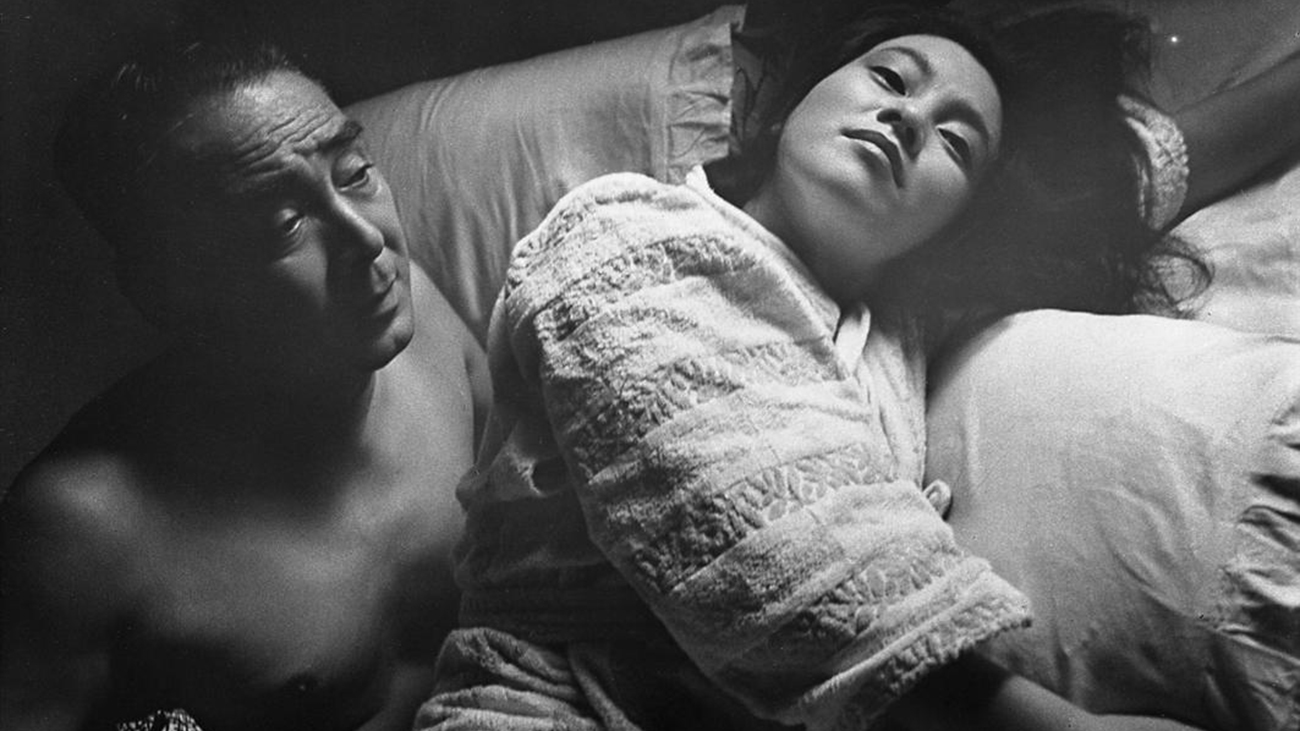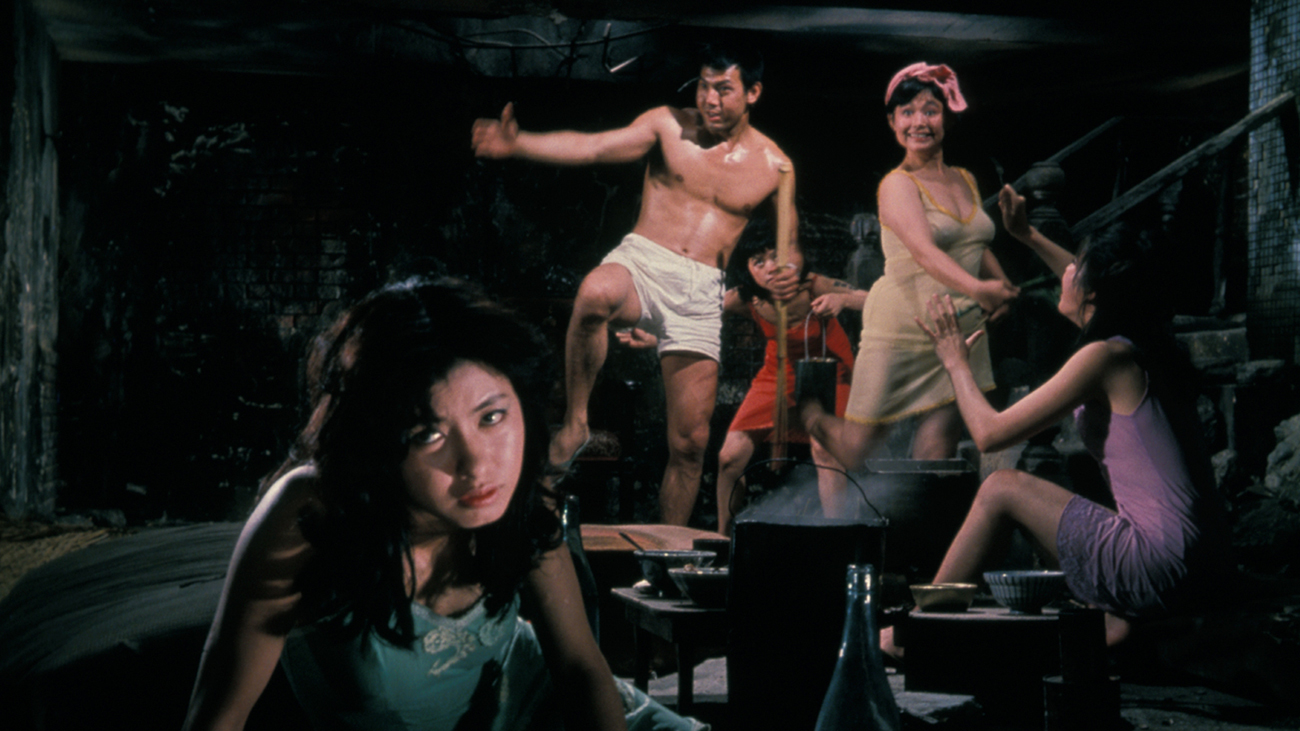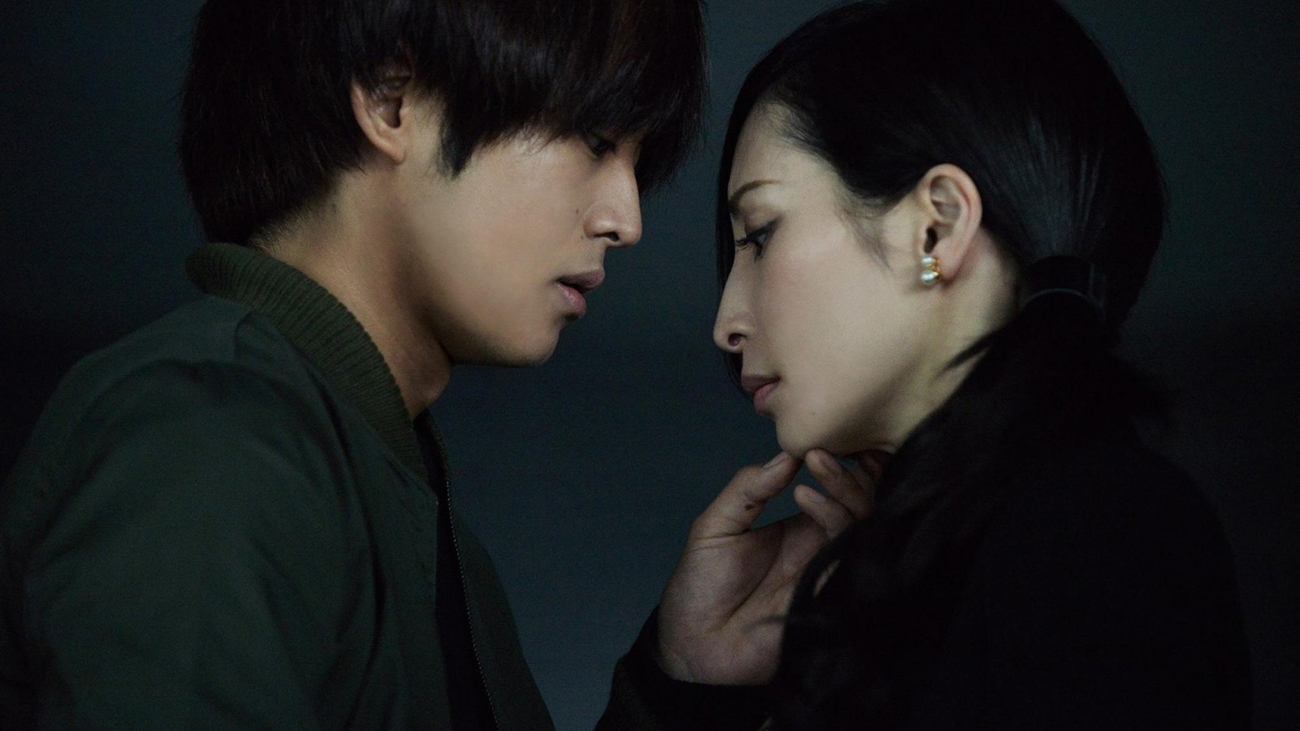Classically referred to as the “oldest profession in the world”, prostitution has endured for centuries in nearly every kind of society, state and socio-economic system. But not every country has as rich a history of courtesans, comfort women and call girls as Japan. After being outlawed in 1956, prostitution continued to thrive but Japan remained inwardly conservative about sex, avoiding the subject in classrooms and at home. However, Japanese cinema has had plenty to say about it, with help from directors Kenji Mizoguchi, Sion Sono, Mika Ninagawa and others.
A tale of prostitution is undoubtedly a larger commentary on women’s place in Japan and their struggle to survive in a society that places a high value on their sexuality and a low value on their humanity – and men who enter this business face their own challenges as well.

The Insect Woman (1963, dir. Shohei Imamura)
A Means of Survival
A common thread weaves through early and modern tales about prostitution: that this line of work is often a last resort. From societal outcasts to those who need to support their family, prostitution was depicted on screen as one of the few professions available to women during economic depression and war.
Kei Kuma’s Sandakan 8 (1974) was adapted from an explosive book that examined a forgotten segment of Japanese women known as ‘karayuki-san’. These women came from poor, rural families and were trafficked throughout Asia in the early 20th century. In the film, an elderly woman recounts being brought to a Malaysian brothel as a young girl to work as a maid. Once she came of age, she was pushed into prostitution in order to clear the debt she accrued from living at the brothel, and to support her family. When she returned home after several years, she was shunned by her family and community, and lived the rest of her life in social exile. Sandakan 8 showed that while prostitution was widespread, entrapping many women and bolstering their families’ pockets, it was still judged as shameful and women were not allowed to re-enter society once they “retired”.
Prostitution can be just one of many jobs a woman takes on throughout her life. Shohei Imamura’s The Insect Woman (1963) depicts a woman who is born into an impoverished family and works first at a mill, but later becomes a prostitute and then a brothel madam. She pragmatically chases after whichever career offers greater wealth than she had before. In a near complete-reversal, Kenji Mizoguchi’s The Life of Oharu (1952) sees a noblewoman fall from grace and be sold by her family as a concubine and then a prostitute.
Poverty is certainly not a state that afflicts only women. In the documentary Boys For Sale (2017), Japanese male prostitutes frankly discussed how they entered the trade. When interviewed, some said they needed to clear high family debt while others were displaced after the devastating 2011 Tōhoku earthquake and became prostitutes upon their arrival to Tokyo. Given accommodation and promised wealth, it’s difficult for vulnerable men to turn down these jobs. However, a few of them were led to believe they wouldn’t have to perform sexual acts, but instead offer company to women and occasionally men. They later discovered sexual acts were unavoidable and that men were their main clientele. The majority of interviewees identified as heterosexual, but they learned how to perform sexual acts with men because to avoid male clients was to avoid working at all. It is worth noting all the men interviewed for the documentary entered the trade willingly, but when the choice is prostitution or destitution, is there really a choice?
These films were truthful in depicting prostitution as a line of work populated by trafficked victims and people who have no other means of making money, but this portrayal certainly casts a shameful shroud over the trade. As the pursuit of sex outside of marriage becomes more socially acceptable and prostitution becoming legal in some countries, with certain women and men choosing it willingly as their profession, we see a trend in cinema towards presenting prostitution as a legitimate means of income and even a path to freedom.

Guilty of Romance (2011, dir. Sion Sono)
“Let me show you what I become at night.”
A filmmaker who has no fear in blowing the lid off Japanese sexuality is Sion Sono. In his film, Guilty of Romance (2011), we observe obedient housewife, Izumi, and her sexless marriage to a famous novelist. After being coerced by a talent agent into making a porno, Izumi experiences a sexual awakening and starts having random encounters with different men before later becoming a part-time prostitute.
Guilty of Romance uses a trope regarding women’s sexuality that first appeared in literature like Madame Bovary, Thérèse Raquin, Tess of the d’Urbervilles and Anna Karenina. This trope asserts that when women take charge of their sexuality, by having passionate affairs, they feel freed from societal constraints that trapped them into a life they did not choose. But they always pay a heavy toll for their licentiousness. In all of the aforementioned novels, the titular woman experiences a gruesome death. In the final sequence of Guilty of Romance, Izumi is beaten after a bad encounter with a client and is lying alone in an alley. But there’s a hint of a smile on her face. Maybe freedom is just the ability to make your own choices, whatever consequences they may bring.
Kenji Mizoguchi frequently told stories of geishas and courtesans, and did so with the utmost skill. Film writer Donald Richie put it best when he wrote: “In the Japanese woman, Japanese directors have discovered the perfect protagonist. This does not mean that Japanese directors are feminists – even Kenji Mizoguchi, though he is often so described. It means rather that these directors in seeking objectivity as well as dramatic revelation have, naturally, shown Japanese women as they are.”1Donald Richie, A Lateral View: Essays on Contemporary Japan, Japan Times, 1987.
Mizoguchi does just this with his film, Street of Shame (1956), which shows the lives of several prostitutes at the same brothel. One of them, Mickey, is a runaway and wanton spender. When her father appears and tries to bring her home, while recounting the shame she has brought upon the family name, Mickey deftly reminds him it was his adultery that first humiliated their family. She says, “You worry what people would say, when you spent your whole life playing around. I’m only following in your footsteps. You lived as you wished. I can do the same and you can’t dare criticize me.” Unwilling to live at home and wanting to wear luxurious clothes and puff cigarettes all day long, prostitution suits Mickey just fine and she’ll be damned if anyone takes it away from her in exchange for being a dutiful daughter next to an unfaithful father. In this instance, Mickey’s use of her sexuality in exchange for money is her path to freedom. The only freedom she can find, anyway.
Men in Japanese films are also shown to be in pursuit of sexual freedom. Only a handful of films explore Japanese male prostitution in a dramatic format and Ryosuke Hashiguchi’s A Touch of Fever (1993) is perhaps the earliest example. The film follows two young men and their experiences servicing male clientele. While money is clearly their biggest motivator in prostituting, it is also a way for them to explore their homosexual desires.
And let’s not forget that women are also buying sex in Japan. Daisuke Miura’s Call Boy (2018) focuses on a character, Ryo, who has struggled in his relationships with women. At the start of the film, he describes women as “boring” and sex as “a lot of work for a fixed sequence of steps.” Upon becoming a prostitute, he learns his self-centered approach to sex kept him from experiencing all its pleasures and understanding women’s complex desires. During his journey, Ryo will remark, “Becoming a gigolo made me feel freer.” One may wonder how getting in touch with one’s sexuality relates to freedom. Consider this: having sex involves the lowering of one’s inhibitions and disregarding insecurities and fears to experience true intimacy with another individual. It can be understood why doing so frequently, and with strangers, would make a person feel “free”. And in this film, we view not only the man’s exploration of his sexuality, but the freeing of the women he serves.
By flipping the gender dynamics, the film presents an entirely different emotional experience. Ryo explains, “Finding the hidden desire in each and every woman and giving it room to breathe became my reason for doing what I do.”
Not a single woman in the other films mentioned describes her work with such interest, possibly because these desires are regarded as perversions when solicited by a man. But because women are not believed to be as equally interested in sex as men, the discovery of their sexual passions is fascinating to uncover. Ryo also does not seek to escape his circumstances, viewing them as preferable to becoming a “corporate slave” and by the end of the film, he is still an active and enthusiastic prostitute, and making all his own choices.

Gate of Flesh (1964, dir. Seijun Suzuki)
Love Don’t Cost a Thing
Author Lesley Downer once perfectly encapsulated the life lived by courtesans, geishas and all other women who floated in that world: “The key rule was to play at love but never, never to allow oneself to feel it.”2Downer, Lesley. Women of the Pleasure Quarters: the Secret History of the Geisha. Broadway Books, 2002. Easier said than done. That’s why love is the cause for great drama, as seen in films like Mika Ninagawa’s Sakuran (2006), and Seijun Suzuki’s Gate of Flesh (1964) and Story of a Prostitute (1965).
Suzuki’s sensual Gate of Flesh sees an injured thief recovering at a brothel filled with women who have made the solemn vow to never give up something that could be paid for – in their particular case, sex. But one woman falls for the hard-boiled criminal, casting aside the consequences. Described as both a soft-core porno and a raw critique of Japan’s post-war condition, the film depicts the murky waters that prostitutes wade in while they work in a profession that involves demonstrating intimacy, love and passion, while asking them to suppress those longings inside of themselves to get the job done. Suzuki would play upon this premise to even more tragic affect in Story of a Prostitute.
In Story of a Prostitute, Harumi works as a comfort woman during the Sino-Japanese war. She is hounded by a ruthless army commander and seeks to seduce his aide in the hopes of enraging the commander and throwing him off her trail. Instead, she and the aide enter into a passionate affair as the war rages on around them. In the film’s final scene, the aide seeks to commit suicide with a grenade and Harumi throws herself upon him and they die together.
Mika Ninagawa’s Sakuran stands apart from previously mentioned films because it was helmed by a rare bird in the Japanese film industry – a female director. The love story here is fascinating, because it’s situational. The protagonist, rebellious and beautiful Kiyoha, falls for one of her clients and even escapes the brothel to be with him. But once she sees him in the world outside, she realises the trappings of the brothel made her desperate for affection. She was fooled into mistaking a sweet word and gentle touch for love, when in actuality she did not love this man enough to live a humble life with him. This is also a rare film with a happy ending for its central prostitute: by the end, Kiyoha has escaped the brothel and while we don’t know what she will do next, she is depicted as being completely free and blissful.
Returning to Mizoguchi’s The Life of Oharu – if the film demonstrated anything, it was how little power women had over their own lives when it came to matters of the heart, marriage and whom they laid with at night. Marriages, for much of Japan’s history, were political arrangements. Concubines and courtesans were bought by men, to show love in exchange for money. And where was the heart left in all this? There was hardly any room for a woman’s heart to dictate her affairs. In fact, to do so at all was dangerous. Oharu’s descent from nobility to outcast begins with a love affair with someone below her rank, which leads to the banishment of Oharu’s family and the unravelling of her life.
What these Japanese films tell us is that love found in a brothel rarely ends well. Due to a debt structure skewed to keep them working in perpetuity, a prostitute’s one hope is a man buying her out, but very few saw their fortunes so reversed. And for prostitutes who believed they had fallen in love, once the money dried up, so did their feelings. These films, quite radically, do not romanticise love. Instead, we are shown how love can drive people to make decisions against their best interest. And there are probably few places other than a brothel where people are more honest about their desires and expectations — and romance only survives where there are still hints of mystery left.

Call Boy (2018, dir. Daisuke Miura)
Japan balances a curious dichotomy. From the outside, it appears to be more sexually adventurous than other nations, open to fulfilling various proclivities and fascinations, but it stays secretive about doing so. Despite what laws may be passed, prostitution will exist in some form but continue to be regarded as a necessary evil, rather than just a necessary necessity. For that reason, Japanese cinema will likely continue to portray prostitution as unseemly and tragic, reeling in women and men from desperate circumstances, and then regarding them as untouchable creatures.
Whether one may enter prostitution by force or voluntarily, one thing remains the same: there is an exchange of services for money. Services that involve an act regarded to be sacred, intimate and an expression of love. What becomes of love, when it can be bought with a stack of bills? Japanese films on prostitution have shown that money is the primary factor driving relationships forged in brothels, and even if love is found between the sheets, it is stunted in its ability to flourish. But what will flourish, for as long as human society exists, is prostitution.
